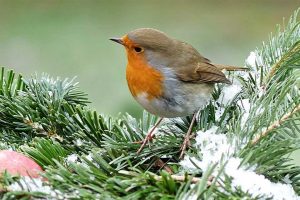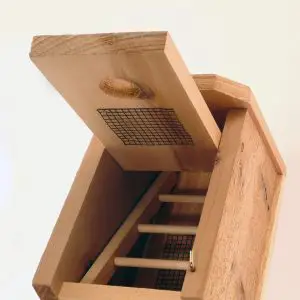Several songbirds gladly make use of nesting boxes. From early spring onwards to hatch and raise their brood. House sparrows and blue tits are just two examples of birds that have up to 4 clutches each season, all in the same box.
When we are sure that the birds have fledged and the adults have abandoned the box, usually late autumn, it is important to remove it for a thorough clean. It prevents future inhabitants from catching a disease from parasites and mould.
But when should you put it back up, should you wait for early spring or do birds use bird boxes in winter?

Not all birds migrate south when the temperature drops. Those that stay need all the help that they can get to help them survive harsh winters.
Not only should we be giving them energy-packed food, but also offering them a sheltered place to rest and roost overnight.
Many birds take advantage of a bird box in winter. When wild birds have spent the day hunting and foraging for food, they are in desperate need of a secure place away from danger.
Birds rarely roost overnight alone; they realise that shared body heat improves their survival chances.
Table of Contents
Birds that use nesting boxes in winter
Wrens – The wren is one of the most prolific users of bird boxes through the winter. If you have ever had the opportunity to see them leave their shelter, at the crack of dawn, prepare to be amazed.
They roost in great numbers; the more birds that can pack into each box creates increased body heat. It is common to see 12-14 wrens tightly packed into one nesting box; however, there have been sightings of more than 40 snuggled together.
Blue tits – Blue tits head for the safety of bird boxes to keep warm overnight. They don’t bother taking any nesting materials in; instead, they rely on the empty wooden box for security.
When a blue tit has used a box through the winter, they may find a mate continue to use it to build their nest in early spring.
The coal tit offers no threat to their cousin the blue tit, and sometimes they shelter overnight in the same bird box.
House sparrows – Both sexes gather hay and grass to add a little extra warmth and comfort to the box during autumn and winter. When the worst of the cold weather passes, they will line it with more substantial materials ready for their eggs. Sparrows have between 1-4 broods each season; the box should be durable and tough enough to last for year-round use.
Woodpeckers – They don’t always rely on the same bird box; woodpeckers keep their options open and use several roosting sites throughout the winter.
Tawny owls – These magnificent birds need a dedicated owl bird box; open-fronted and much larger than standard songbird ones. Position them high in a tree and, if you’re lucky, an owl will roost when the coldest weather hits. They may well go on to lay their eggs and raise their young when spring rolls around.
Winter roosting boxes
Bird boxes and nesting boxes are different names for the same things. Although they are secure spots for winter, roosting boxes are designated to give the birds the best chance of survival.

Roosting means the time when a bird rests or sleeps. If it isn’t alert to dangers, the box should give them additional security from night prowling predators.
A roosting box looks taller than a standard one, to cater for extra perches. They maximise the number of birds that fit inside simultaneously, to share body heat.
The entrance hole is at the bottom to keep most of the heat in and predators out.
Tips for winter bird boxes
Most cavity-nesting songbirds that make use of birdhouses in spring continue to do so through winter.
You don’t need to buy new boxes; there are inexpensive ways of adapting your existing ones.
- Often more than one bird at a time uses a nesting box. It is a good idea to fit some small perches at the top of the box to prevent them from piling on each other and suffocating.
- If you’re making a makeshift box, place the entrance hole near the bottom; remember warm air rises.
- Position the boxes up high, above 3-metres if possible. Garden birds are more likely to use them if they feel safe from predators. It is even better to attach them to a metal pole; cats and squirrels can’t climb them as they can wooden posts.
- Vents in a bird box that help keep the birds cool in summer let cold drafts in. Foam weatherstripping is affordable, easy to fit, and even easier to remove in spring.
Final thoughts
Songbirds store fat all year round in preparation for winter. Combine this warming layer with their feathers, especially the inner downy fluffy ones, and they have some protection from the elements.
Cavity nesting birds use bird boxes in winter as a critical part of their survival plan. We can help by leaving nutritious food, fresh drinking water, and providing them with a clean, safe place to roost.
